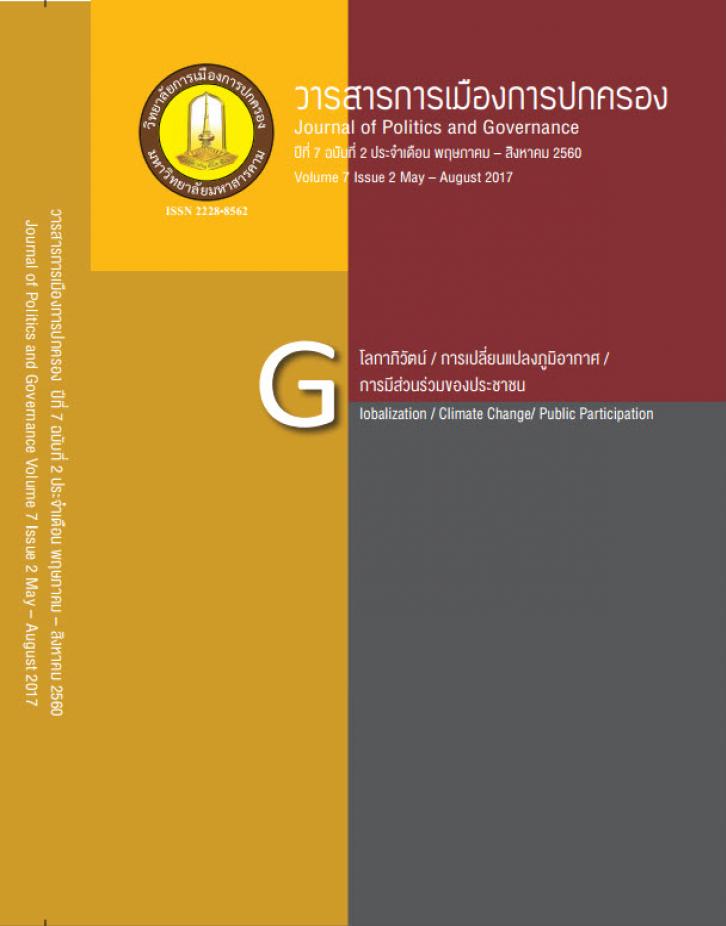The Adaptation of Agricultural Households in the Repeated Flooding Area: A Case Study of Tambon Yangtajang, Amphor Khosumpisai, Mahasarakham Province
Main Article Content
Abstract
The aims of this study - the Adaptation of Agricultural Households in the Repeated Flooding Area: A case Study of Tambon Yangtajang, Amphor Khosumpisai, Mahasarakham Province – are to investigate how the agricultural households adjust themselves, and how the governmental agencies manage disaster, the repeated flooding in particular. The study also looks for a platform of agricultural community management. The area of study covers five villages in Tambon Yangtajang, Amphor Khosumpisai, Mahasarakham Province. The research methods include documentary analysis, area surveys, elite interviews and focus groups and descriptive analysis. The finding reveals that the agricultural households in the targeted area of study, Tambon Yangtajang, adjust themselves to live in the repeated flooding areas. This area is situated in Chi River Basin. It is also categorised as a medium level of repeated flooding area, which means it is found regularities of repeated flooding, experience waterlogging four to seven times in a decade and a medium level of risks in an investment in the agricultural development. Farmers, consequently, change their patterns of rice planting from growing the short-lived rice grains to the long-lived ones. This change aims to serve the market demands, rather than planting rice in accordance with the flood. Moreover, the irrigation projects help farmers to grow the double-crop field. This leads to the fact that the farmers are keen to produce for the market than for self-sufficiency. It is worth noting that the flood provides an opportunity for the farmers to do fishing and grow the double-crop field in order to subsidise a loss caused from the flood in the in-season rice field.
The second point by which the study found in the governmental agency’s disaster management is that people in the communities and the agency prepare themselves before, in-between and after the flood occurred. In terms of the preparedness before the flood occurred, it emphasised on closed surveillance of the risks of flooding. This surveillance had been done in four channels which from the Ubonrat Dam, from Amphor to Tambon to the village, from the Thai Meteorological Department and from the committees of the village (to disseminate the flooding news). While the flood happened, most of the villagers still lived in their houses. Some of them went to somewhere else for the temporary jobs. After the flood had gone, villagers paid attention first to compensation for destruction of their rice fields and houses. It was because this affected their psychological aspects. Living in the flood for some period of time causes stress, especially their concerned of how to repay debts. However, the research found that there existed forms of debt-relieved methods in the communities such as the village funded or others financial tools. Additionally, the governmental agencies closely help communities. The major actors are officials in the province, the districts, and the local government. The bureaucrats in the province are the main mechanism to supervise the disaster management at large. The local governments, like the Yangtajang local administration, has a role to prevent and reduce the risks of disaster in their area. They also act as a hub to facilitate other agencies in helping people in the area. Recommendations from the study are divided into two level. In the households’ level, it is necessary to maximise a profit from a double crop field, especially if there is a flood in the in-season rice field. In the community’s level, it is important to reduce a risk of oversupplying. This will help to alleviate farmers’ worries of lacking the market to sell the products. Also, it will encourage the farmers to change their ways of production.
Article Details
References
ชาย โพธิสิตา. (2552). ศาสตร์และศิลป์แห่งการวิจัยเชิงคุณภาพ. พิมพ์ครั้งที่ 4. กรุงเทพฯ:อมรินทร์พริ้นติ้งฯ.
ทรงชัย ทองปาน. (2554). การปรับตัวของเกษตรกรทำนาในพื้นที่น้ำท่วมซ้ำซาก อำเภอชุมแสง จังหวัดนครสวรรค์. กรุงเทพฯ: คณะศิลปศาสตร์ มหาวิทยาลัยธรรมศาสตร์.
ทวิดา กมลเวชช. (2554). คู่มือการจัดการภัยพิบัติท้องถิ่น. กรุงเทพฯ: วิทยาลัยพัฒนาการปกครองท้องถิ่น สถาบันพระปกเกล้า.
บุญธิดา เกตุสมบูรณ์. ผู้แปล. (2557). คู่มือการวิเคราห์ขีดความสามารถและความเปราะบางของชุมชนต่อการเปลี่ยนแปลงสภาพภูมิอากาศ. แปลจาก Climate Vulnerability and
Capacity Analysis Handbook: CVCA. กรุงเทพฯ: มูลนิธิรักษ์ไทย.
ปฐมาภรณ์ บุษปธำรง. (2555). การจัดการภัยพิบัติ : ปรัชญาสวัสดิการและการประยุกต์. วารสารราชบัณฑิตยสถาน. 37(3), กรกฎาคม – กันยายน 2555.
สำนักงานคณะกรรมการพัฒนาเศรษฐกิจและสังคมแห่งชาติ. (2554). การจัดการภัยพิบัติและการฟื้นฟูบูรณะหลังการเกิดภัย กรณีศึกษาประเทศไทยและต่างประเทศ. กรุงเทพฯ.
องค์การบริหารส่วนตำบลยางท่าแจ้ง. (2557). แผนพัฒนา 3 ปี (พ.ศ. 2557 – 2559). มหาสารคาม:สำนักงานองค์การบริหารส่วนตำบลยางท่าแจ้ง
เว็บไซต์
สำนักงานเศรษฐกิจการเกษตร สำนักวิจัยเศรษฐกิจการเกษตร กระทรวงเกษตรและสหกรณ์. (2555). การศึกษาโครงสร้างอาชีพและการปรับตัวของครัวเรือนเกษตรในพื้นที่น้ำท่วมซ้ำซาก
ภาคเหนือตอนล่าง. สืบค้นเมื่อวันที่ 18 พฤษภาคม 2557. แหล่งเข้าถึงข้อมูลhttp://www.oae.go.th/ewtadmin/ewt/oae_bear/ewt_news.php?
สำนักป้องกันภัยธรรมชาติและความเสี่ยงทางการเกษตร กรมพัฒนาที่ดิน กระทรวงเกษตรและสหกรณ์. (2557). พื้นที่น้ำท่วมซ้ำซาก. สืบค้นเมื่อวันที่ 12 พฤษภาคม 2557. แหล่งเข้าถึงข้อมูล http://irw101.ldd.go.th/data/data_flo.html
สำนักป้องกันภัยธรรมชาติและความเสี่ยงทางการเกษตร กรมพัฒนาที่ดิน กระทรวงเกษตรและสหกรณ์. (2557). พื้นที่เสี่ยงต่อการเกิดภัยน้ำท่วมซ้ำซาก ประเทศไทย รายตำบล.
สืบค้นเมื่อวันที่ 12 พฤษภาคม 2557. แหล่งเข้าถึงข้อมูลhttp://irw101.ldd.go.th/data/data_flo.html
สำนักป้องกันภัยธรรมชาติและความเสี่ยงทางการเกษตร กรมพัฒนาที่ดิน กระทรวงเกษตรและสหกรณ์. (2557). แผนที่น้ำท่วมซ้ำซากในประเทศไทย. สืบค้นเมื่อวันที่ 12 พฤษภาคม
2557. แหล่งเข้าถึงข้อมูล http://irw101.ldd.go.th/data/images/flood-new.jpg
สุดารัตน์ คำปลิว. (2555). รูปแบบการจัดการน้ำกุดอ้อ โดยกระบวนการมีส่วนร่วมของชุมชนบ้านโขงใหญ่ ตำบลมะค่า อำเภอกันทรวิชัย จังหวัดมหาสารคาม. สืบค้นเมื่อวันที่
18 พฤษภาคม 2557. แหล่งเข้าถึงข้อมูล http://www.oae.go.th/ewtadmin/ewt/oae_baer/ewt_news.php?
มูลนิธิชีววิถี. (2555). ชุมชนกับการปรับตัวต่อการเปลี่ยนแปลงสภาพภูมิอากาศ บทเรียนจากพื้นที่และข้อเสนอเชิงนโยบาย. สืบค้นเมื่อวันที่ 18 พฤษภาคม 2557. แหล่งเข้าถึงข้อมูล
http://www.biothai.net/node/11294
มูลนิธิเกษตรกรรมยั่งยืน (ประเทศไทย). (2556). การปรับตัวของเกษตรกรรายย่อย กรณีศึกษาบ้านขี้เหล็ก ตำบลเขวาใหญ่ อำเภอกันทรวิชัย จังหวัดมหาสารคาม. สืบค้นเมื่อวันที่
18 พฤษภาคม 2557. แหล่งเข้าถึงข้อมูล http://sathai.org/th/news/hot-issue/item/482-2014-01-15-09-40-36.html
The COMET Program. (2010). Flash Flood Early Warning System Reference Guide. สืบค้นเมื่อวันที่ 25 กรกฎาคม 2557. แหล่งเข้าถึงข้อมูล https://www.meted.ucar.edu/
Training_module.php?id=958#.VB7ExWYxW2c


